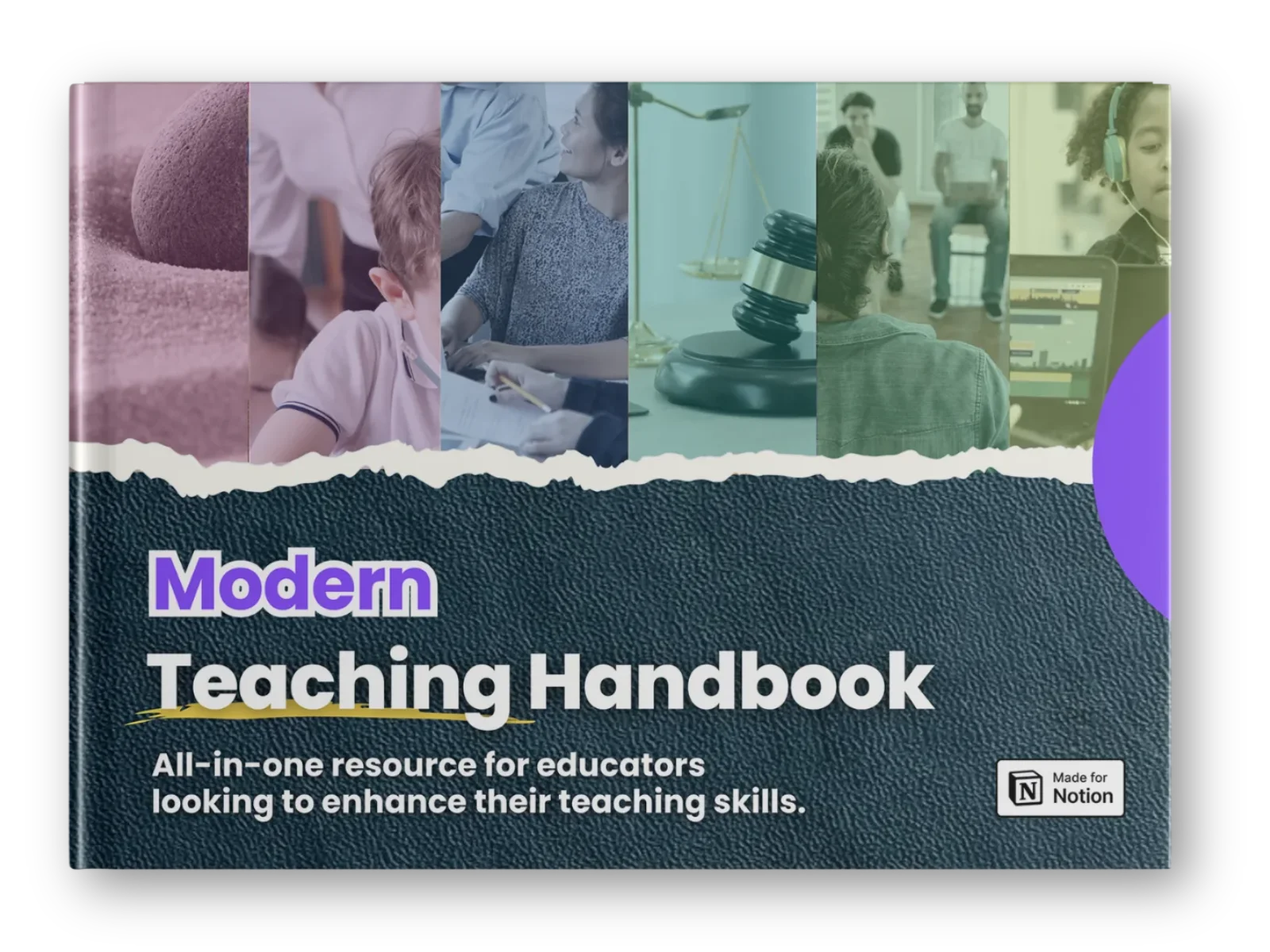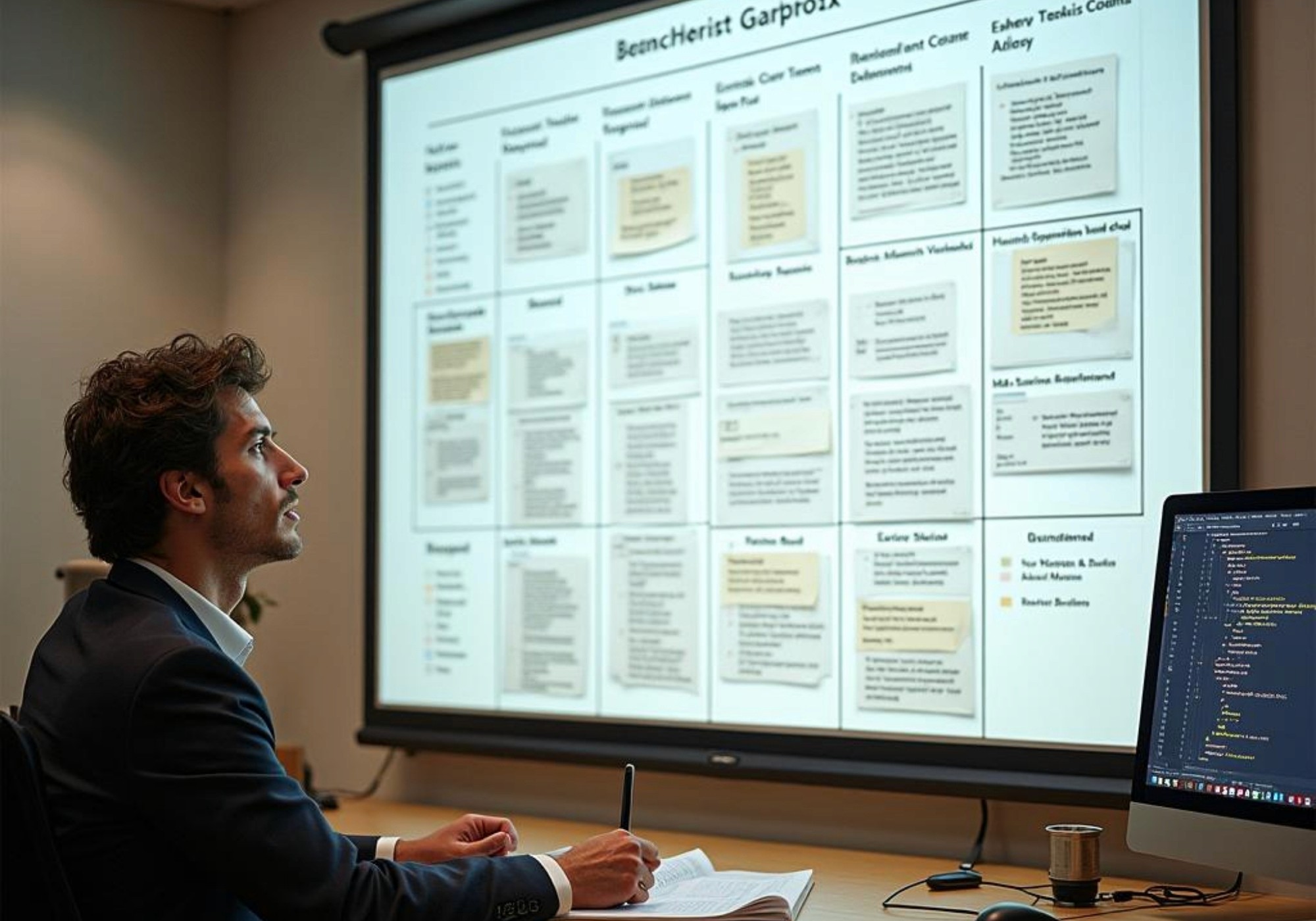Modern Teaching Handbook
Master modern education with the all-in-one resource for educators. Get your free copy now!



Teacher Work-Life Balance: Evidence-Based Strategies
Teacher Work-Life Balance: Evidence-Based Strategies
Teacher Work-Life Balance: Evidence-Based Strategies

Article by
Milo
ESL Content Coordinator & Educator
ESL Content Coordinator & Educator
All Posts
Picture this: it’s 9 PM on a school night, and you’re still grading papers at your kitchen table. Your third cup of lukewarm coffee sits untouched as you skim through rubrics, wondering how anyone balances work and personal life in this profession. Sound familiar? If so, you’re not alone. For many teachers, work-life balance feels like chasing a unicorn—magical and completely out of reach.
Teaching is, without a doubt, one of the most rewarding professions. You’re shaping young minds, inspiring curiosity, and making a real impact. But let’s be honest: it’s also demanding. Between lesson planning, grading, parent communication, administrative duties, and extracurricular involvement, your to-do list seems endless. Add your personal commitments—family, friends, hobbies, and, oh yeah, sleep—and it’s easy to feel overwhelmed.
But here’s the good news: work-life balance isn’t a myth. It’s achievable. Like any skill, it takes awareness, effort, and the right strategies. Let’s explore what teacher work-life balance means and why it’s worth striving for.
Picture this: it’s 9 PM on a school night, and you’re still grading papers at your kitchen table. Your third cup of lukewarm coffee sits untouched as you skim through rubrics, wondering how anyone balances work and personal life in this profession. Sound familiar? If so, you’re not alone. For many teachers, work-life balance feels like chasing a unicorn—magical and completely out of reach.
Teaching is, without a doubt, one of the most rewarding professions. You’re shaping young minds, inspiring curiosity, and making a real impact. But let’s be honest: it’s also demanding. Between lesson planning, grading, parent communication, administrative duties, and extracurricular involvement, your to-do list seems endless. Add your personal commitments—family, friends, hobbies, and, oh yeah, sleep—and it’s easy to feel overwhelmed.
But here’s the good news: work-life balance isn’t a myth. It’s achievable. Like any skill, it takes awareness, effort, and the right strategies. Let’s explore what teacher work-life balance means and why it’s worth striving for.
Modern Teaching Handbook
Master modern education with the all-in-one resource for educators. Get your free copy now!

Modern Teaching Handbook
Master modern education with the all-in-one resource for educators. Get your free copy now!

Modern Teaching Handbook
Master modern education with the all-in-one resource for educators. Get your free copy now!

Introduction to Teacher Work-Life Balance
What Is Work-Life Balance?
At its core, work-life balance is the ability to divide your time, energy, and attention effectively between your professional and personal life. It doesn’t mean achieving a perfect 50/50 split every day (spoiler: that’s impossible). Instead, it’s about creating harmony where work doesn’t constantly overshadow your personal life or vice versa.
For teachers, this balance might look like:
Leaving schoolwork at school: No more grading papers until midnight every night.
Prioritizing personal well-being: Taking time for hobbies, exercise, or simply relaxing.
Being present in both roles: Fully engaging with students during class and fully engaging with family or friends after work.
It’s important to remember that balance looks different for everyone. Your version of harmony may not match your colleague’s—and that’s okay.
Why Do Teachers Struggle With Balance?
Teaching is unique. It’s not a "clock-in, clock-out" job. Your work doesn’t end when the bell rings. There’s always something more you could do—an extra assignment to grade, a parent email to send, or a lesson plan to refine. Plus, societal expectations can pile on pressure, making teachers feel like they have to give 110% to avoid being judged.
Common challenges include:
Emotional investment: Teaching often feels personal. You care deeply about your students’ success, which can blur the lines between work and life.
Heavy workloads: Administrative tasks, professional development demands, and extracurricular commitments can eat into personal time.
Guilt and Perfectionism: Many teachers feel guilty for taking time off because they believe they should always be "on."
Throw in unexpected disruptions—like that “urgent” email from a parent at 8 PM—and it’s easy to see why balance feels elusive.
Why Work-Life Balance Matters
Without balance, burnout looms. Burnout isn’t just feeling tired now and then (which, let’s face it, is normal for anyone). It’s a state of chronic stress and exhaustion where motivation nosedives, productivity drops, and teachers might even consider leaving the profession altogether.
Achieving balance benefits not just you but also your students:
Increased energy: When you’re well-rested and recharged, you bring more enthusiasm to the classroom.
Better focus: A clear mind means fewer mistakes and more creative teaching approaches.
Modeling healthy behaviors: You show students that it’s okay—and necessary—to value personal time.
Does this mean balance will eliminate every bad day? Of course not. Teaching has its challenges. But finding a sustainable rhythm can make the tough days more manageable.
Ultimately, recognizing the importance of balance is the first step in creating it. You don’t need to overhaul your entire life overnight, but small, mindful changes can make a big difference. Ready to hear how to make it happen? Let’s dive into the strategies next.

Importance of Work-Life Balance for Teachers
Picture this: you’re juggling lesson plans, grading, parent emails, faculty meetings, and maybe even a last-minute request to cover another teacher’s class. Sound familiar? Teachers are masters of multitasking, but without a proper work-life balance, this constant hustle can lead to burnout faster than you can say “pop quiz.”
Why Balance Matters (and What Happens Without It)
Teaching goes far beyond the classroom walls—it’s a job that often spills into early mornings, late nights, and precious weekends. But here’s the thing: when your work life constantly intrudes on your personal life, something’s bound to give. And unfortunately, it’s often your mental health, physical well-being, or relationships. Studies have shown that teachers who lack work-life balance are more likely to experience:
Chronic stress: The never-ending to-do list can send your stress levels through the roof, potentially leading to health problems.
Burnout: Exhaustion isn’t just physical. Emotional and mental burnout drains your passion for teaching, leaving you feeling disengaged and overwhelmed.
Decreased job performance: Let’s face it—when you’re running on fumes, you’re not at your best in the classroom.
Lower job satisfaction: An imbalance makes teaching feel like a grind rather than the rewarding profession it can be.
But here’s the good news: prioritizing balance isn’t selfish—it’s essential. A well-rested, happy teacher is far more effective than an overworked, frazzled one. You deserve to thrive both inside and outside the classroom.
Benefits of a Healthy Work-Life Balance
When you strike the right balance between professional and personal life, it’s a win not only for you but for your students and school community as well. Here’s why it’s worth investing in:
Boosted energy and focus: Time to recharge outside of work helps you show up each day feeling energized and mentally clear.
Improved relationships: You’ll have more space in your life to connect meaningfully with family, friends, and yes, even your colleagues.
Higher creativity: A healthy balance lets your brain take breaks, which is when new ideas and solutions tend to pop up. (Ever noticed how the best ideas come while you’re in the shower?)
Sustainability: Teaching is a marathon, not a sprint. A balanced workload ensures that you can keep doing what you love for the long term without losing yourself in the process.
A Relatable Example: Miss Jones’ Dilemma
Take Miss Jones, a middle school science teacher who used to spend every Sunday evening grading papers. She would sacrifice family dinners and her favorite Netflix binges in the process. Eventually, she realized this constant push was making her cranky during school and absent-minded at home. After committing to setting boundaries (hello, Saturday morning grading sessions!) and prioritizing family time, Miss Jones found herself more present at work and happier in her personal life. Her students noticed her newfound energy, and she felt proud of being both a great teacher and a great mom.
It’s About Being Human, Not Superhuman
Let’s be real—teachers often feel the pressure to wear a cape and be everything to everyone. But here’s the secret: you’re human, not superhuman. Striving for balance isn’t about “doing it all”; it’s about making sure you have enough energy, joy, and time for the things you value most. It’s okay to shut your laptop at 5 p.m. or (gasp!) skip grading for one night to have dinner with your family. Small shifts like this can make a huge difference.
Remember, your well-being isn’t a luxury—it’s a necessity. By maintaining work-life balance, you’re not just taking care of yourself; you’re setting an example for your students and giving them your very best. Let’s normalize making this a priority, both in our classrooms and in our lives. Ready to bring back that spark? Let’s keep the conversation going in the next chapter!

Evidence-Based Strategies for Achieving Balance
Did you know that nearly 60% of teachers report feeling chronically stressed due to their workload? If you’re one of them, rest assured—you’re not alone, and there are actionable strategies you can use right now to reclaim some of that balance. Let’s dive into practical, research-backed ways to create more harmony between your professional and personal life.
Prioritize Your Tasks with Purpose
Not all tasks are created equal. When your to-do list looks longer than a grocery store receipt, it’s time to prioritize like a pro.
Try the Eisenhower Matrix: This technique divides your tasks into four categories:
Urgent and important (tasks to tackle immediately).
Important but not urgent (tasks to schedule for later).
Urgent but not important (tasks to delegate or minimize).
Neither urgent nor important (tasks to eliminate).
For example, responding to a parent email about this week’s homework might fit in the "urgent and important" box, but revamping your classroom bulletin board likely falls into "not urgent, not important."
The “Big Three” Rule: Each morning (or the night before), jot down three key priorities for the day. These are the most important things that, if completed, will make you feel accomplished. Everything else can wait.
Batch Related Tasks: Group similar activities—like grading papers, replying to emails, or writing lesson plans—into focused time blocks. Research shows that bouncing between tasks wastes time and drains energy.
Use Technology as Your Ally
One of the perks of living in the digital age? There’s an app for almost everything. Smart tools can streamline your workload and free up space in your calendar.
Google Calendar or Outlook: Schedule blocks of time for focused work, breaks, and personal activities. Treat your personal time as seriously as a parent-teacher meeting.
Notion: This project management app is perfect for organizing lesson plans, committee responsibilities, and even personal goals.
Grading Apps: Tools like GradeCam or ClassDojo make grading and tracking student progress faster and less tedious.
Still, don’t let technology overwhelm you. Balance it by going analog when needed, like jotting down quick notes in a planner or journaling your thoughts—sometimes old-school methods are just as therapeutic.
Embrace Self-Care as a Strategy
You might be rolling your eyes at the phrase "self-care," but stick with me: it’s not just bubble baths and spa days. Here, self-care means intentionally investing in your physical, mental, and emotional health—and research supports its benefits.
Schedule Short Breaks: Studies suggest that taking a 5-minute break every 25-30 minutes (the “Pomodoro Technique”) boosts productivity. Use those moments to stretch, grab water, or simply breathe.
Set a Non-Negotiable End Time: Commit to stopping work at a specific time every evening. When that moment arrives, shut the laptop, pack up your bag, and walk away guilt-free.
Connect with Colleagues: Teaching can feel isolating, but you can lean on your peers for support. Swap strategies, share resources, or just bond over a quick coffee—sometimes venting with someone who “gets it” is the best therapy.
Learn to Say “No”
This might sound tough (especially if you’re the go-to person on campus), but saying “yes” to everything is a recipe for burnout. Consider this: every time you say “yes” to one thing, you’re saying “no” to something else—like your evening run, family dinner, or the novel gathering dust on your nightstand.
Here’s how to approach saying "no" without guilt:
Be polite yet firm. For example, “Thank you for thinking of me, but I can’t take on another committee right now.”
Offer alternatives. Suggest someone else who might be a good fit or propose revisiting the idea when your schedule lightens.
Remember your capacity. You cannot pour from an empty cup, no matter how much you care.
Build Habits, Not Hype
Finally, aim for consistency over grand, unsustainable gestures. Incorporating small, evidence-based habits—like delegating more tasks, logging out of email after work hours, or taking a 10-minute walk during lunch—adds up over time. The key is progress, not perfection.
And guess what? No strategy will be perfect every day (or every week). What matters most is trying, adjusting, and giving yourself grace when things don't go as planned. Ready to try? Let’s take one step toward that balance today—you’ve got this.

Time Management Techniques for Educators
When it comes to teaching, the "to-do" list often feels never-ending. Between lesson planning, grading, meetings, and emails, it’s easy to feel like there aren't enough hours in the day. Sound familiar? Don’t worry—you're not alone! Mastering time management doesn’t mean adding more hours to your day (as much as we all wish that were possible). It’s about learning to use your time smarter, so you can get things done and still have space to breathe. Let’s dive into some practical strategies.
1. Prioritize Like a Pro
Not all tasks are created equal—that’s the first rule of effective time management. The trick is figuring out what truly matters and tackling those items first. Here's how to get started:
The Eisenhower Matrix: Divide your tasks into four categories—what’s urgent and important, important but not urgent, urgent but not important, and neither. Focus on the first category and delegate or defer the others whenever possible.
The "Big Three" Approach: Each day, choose three key tasks that absolutely need to get done. These become your top priorities. Anything else you do is extra credit.
Example: If your book club meeting is tonight, prepping tomorrow's lesson plan might outrank reorganizing your classroom bookshelves. Both are good goals, but only one is urgent.
2. Batch Similar Tasks
Switching between grading, answering emails, and lesson planning all within an hour is a surefire way to fry your brain. Save energy and stay focused by "batching" tasks—grouping similar activities and tackling them all at once.
Grade all your tests in one sitting instead of doing a few here and there.
Dedicate 30 minutes right after school to respond to emails, then don’t revisit your inbox (unless an emergency pops up).
Plan creative activities for the next week's lessons all in one go, so you can keep your planning momentum.
Batching saves time and helps avoid the dreaded "what was I doing again?" moments.
3. Set a Timer and Beat the Clock
Ever notice how fast you can clean your house when guests are 10 minutes away? That’s the power of a time crunch! You can recreate this energy by setting timers for tasks.
Use the Pomodoro Technique: Work for 25 minutes on one task, then take a 5-minute break. Repeat four times, then take a longer break.
Challenge yourself to finish grading a stack of assignments in 40 minutes. If you don’t finish, fine—but you’ll likely get much further than if you didn’t set a limit.
Example: Tell yourself, "I’ll spend 15 minutes on these emails, then go grab that chocolate bar I’ve been eyeing." Motivation? Check.
4. Embrace the Power of "No"
Here’s a secret: saying no to others means saying yes to your sanity. Teachers are often pulled in many directions, but not every request deserves your time.
Set boundaries with parents and colleagues: Do you really need to join that optional committee or answer emails at 10 p.m.? Probably not.
Politely decline extras: “I’d love to help, but I have other commitments right now” is a magic phrase you should memorize.
Remember, your core responsibilities—teaching and supporting your students—deserve the bulk of your attention. The rest? It’s okay to say, “Not today.”
5. Automate and Simplify
Why do something manually if a tool or system can help? These days, there are countless apps and hacks designed to save educators time:
Google Classroom or other LMS tools: Post assignments, share feedback, and cut down on paperwork.
Grading tools: Platforms like Quizizz or Edmodo can auto-grade quizzes and even send feedback to students.
Pre-made templates: Use pre-made rubrics, lesson-plan outlines, and parent communication templates to avoid reinventing the wheel.
Example: Imagine being able to copy-paste a behavior note email template instead of typing one from scratch. That’s five minutes of your life saved!
Time management can feel like juggling flaming torches, but you don’t have to master it overnight. Start by experimenting with these techniques and see what works best for your unique blend of responsibilities and personality. Before you know it, you’ll be swapping stress for efficiency—while finally finding time for the things you truly love, both inside and outside the classroom.
Ready to steal back some precious time? Let’s make it happen!

Setting Boundaries Between Work and Personal Life
"Just one more email." How often have you said this to yourself, only to look up and realize it's way past dinner time? For teachers, the line between work and home often feels blurred. Grading papers piles up, lesson plans loom, and there are always a few stragglers in your inbox demanding attention. But here's the truth—without firm boundaries, burnout is practically inevitable. Setting clear lines between work and personal life is crucial for your health, happiness, and longevity in the teaching profession. Let’s explore how to make it happen.
Why Boundaries Matter
Imagine trying to pour water from an empty pitcher—it just doesn’t work. The same goes for teaching. If you’re constantly "on," you’ll quickly drain your energy supply, leaving little for yourself, let alone your students. Boundaries:
Protect your mental and physical health.
Allow you to recharge emotionally and creatively.
Improve your efficiency when you’re at work.
Set an example for peers and students about prioritizing well-being.
Without boundaries, the workday never ends. Don’t let teaching take over your life!
Practical Strategies to Set Clear Boundaries
Setting boundaries isn't about shutting your classroom door at 3 p.m. and forgetting your students exist. It’s about intentional, manageable shifts in how you approach your work-life dynamic. Here's how:
1. Define Your “Work Hours”
Establish a clear start and end time for your workday. Sure, emergencies arise, but sticking to a standard schedule as often as possible creates consistency. For example:
Arrive 30 minutes before school starts to prep without distractions.
Commit to leaving no later than 30-60 minutes after the final bell rings.
Once you get home, avoid checking emails or grading papers unless it’s absolutely necessary. Leave the teacher hat on your desk.
2. Set Tech Boundaries
Technology is a sneaky culprit when it comes to blurred boundaries. Emails can ding at 10 p.m., and a quick “reply” can turn into an hour-long rabbit hole. Consider these steps:
Disable work email notifications outside of work hours.
Use separate apps or folders for personal and work-related accounts.
Set an “Out of Office” auto-reply for evenings or weekends to gently communicate your availability.
One teacher shared how she physically powers down her work laptop every Friday by 5 p.m. It’s a symbolic (and actual) boundary she loves.
3. Create a “Transition Ritual”
What’s the signal that your professional day is done? A small ritual can help switch your mindset from “teacher mode” to “personal life mode.” Ideas include:
A short walk or workout after work.
Listening to a favorite podcast on your drive home.
Changing out of your “work clothes” as soon as you walk in the door.
These seemingly small actions can do wonders to mentally separate work from home.
Communicating Boundaries to Others
Setting boundaries gets tricky when others—colleagues, parents, or even students—don’t respect them. That’s why communication is key. Try these approaches:
Politely remind parents or students of your availability: “I respond to emails between 8:00 a.m. and 4:00 p.m. I’ll get back to you as soon as I can.”
Work with colleagues to brainstorm ways to streamline tasks during school hours, like co-grading or sharing resources, to reduce after-hours workloads.
If a school leader often adds last-minute requests, respectfully set limits: “I’d love to help, but I need at least 24 hours to fit this into my schedule.”
Boundaries aren’t just for yourself—they teach others how to interact with you in a respectful and healthy way.
Building boundaries is not selfish—it’s smart. Teaching is a demanding job, but it doesn’t have to consume your entire life. By reclaiming your personal time, you’ll gain energy, focus, and a renewed passion for helping your students succeed. So the next time your inbox calls your name at bedtime, remember: You can’t pour from an empty pitcher. Prioritize yourself, and you’ll show up better for everyone else.

The Role of School Administration in Supporting Balance
Imagine this: you've just wrapped up a long day of teaching, your lesson plans for the next week are only half done, and your email inbox is overflowing with unanswered messages. Sound familiar? For many teachers, this scenario feels all too real. But here’s the truth: school administration plays a huge role in whether teachers reach burnout or thrive with a healthy work-life balance. So, how can administrators step up and create an environment where educators don't just survive but flourish?
Leading by Example
Ever heard the phrase “actions speak louder than words”? Administrators set the tone for work-life balance across the school. If principals and school leaders are regularly sending late-night emails or staying at school until 9 p.m., staff might feel pressured to do the same. On the flip side, when administrators model healthy behaviors—like taking actual lunch breaks, leaving at reasonable hours, or advocating for time off—it sends a strong, positive message.
Example: A principal can create "email-free zones," like no emails after 6 p.m., to encourage downtime for staff.
Pro Tip for Admins: Be intentional. Announce ahead of time, “I’m out of the office for family time—but I’ll address any urgent matters tomorrow.” It normalizes prioritizing personal life.
Open Conversations About Burnout
Talking about stress and balance shouldn’t be a taboo subject. Teachers often hesitate to voice frustration or admit they’re struggling for fear of looking “weak” or unprofessional. Administrators can shift that culture by starting open, judgment-free conversations.
How: Host regular check-ins with small groups of staff. Instead of diving into data or grades, ask, “How are you doing? What’s on your plate?”
Outcome: When teachers feel they can speak honestly, administration gets a clearer picture of what’s working and what isn’t—leading to relevant solutions.
Reducing Administrative Overload
Let’s be real: paperwork, mandatory meetings, and constant assessments can consume a teacher’s day. Many tasks aren’t directly tied to student success but are required by the system, often leaving teachers gasping for room to actually teach. Administrators who want to support their staff should trim the excess wherever possible.
Tangible Tips:
Skip unnecessary meetings and make use of virtual updates (e.g., a weekly newsletter with essential info).
Streamline processes, like grading systems or attendance tracking.
Offer clerical support for recurring, time-heavy tasks.
Big Picture: By shedding administrative “fluff,” teachers can redirect energy to teaching and personal recovery time.
Flexible Scheduling and Support
Outside a standard school day, life happens. Teacher-parent conferences, grading marathons, and extra-curricular duties can stretch schedules endlessly. By offering flexibility, administrators can help teachers reclaim a sense of control.
Offer planning periods that are actually uninterrupted.
Rotate evening events among staff to avoid overburdening the same people every time.
Allow for mental health days—no guilt, no stigma.
Recognizing and Celebrating Teachers
Sometimes all it takes is a little appreciation to help teachers feel supported. Small gestures make a big difference, especially after long weeks of grading papers or managing challenges in the classroom.
Ideas to Celebrate Teachers:
Handwrite thank-you notes or recognize effort publicly during staff meetings.
Provide lunches or small treats during busy times, like parent-teacher conference week.
Create a shout-out board: a bulletin where teachers post kind notes about one another.
Wrapping It All Up
When administrators prioritize teacher well-being, it doesn’t just improve work-life balance—it strengthens the entire school community. Happy, supported teachers bring more energy, creativity, and patience into their classrooms. So, whether it’s reducing unnecessary tasks, allowing flexibility, or simply leading by example, school leaders hold the power to create a culture of balance.
Administration isn’t just about keeping a school running; it’s about caring for the people who make it thrive. After all, when teachers win, so do students.

Resources for Teachers to Improve Well-Being
Picture this: you slog through the day as a teacher, giving your all to your students, only to go home with an endless pile of grading and lesson planning. Exhausted, you barely have time to breathe, let alone prioritize self-care. Sound familiar? You’re not alone. The good news is that there are plenty of resources out there tailored to help educators reclaim their peace of mind, improve their well-being, and boost their overall quality of life.
Mental Health Support for Teachers
Teaching can be emotionally draining—after all, you’re not just shaping young minds; you’re also juggling students’ emotions, parents’ expectations, and administrative demands. Prioritizing mental health resources is a must.
Employee Assistance Programs (EAPs): Many schools offer EAPs, which often include free counseling sessions, mental health resources, and referrals to specialists. It’s a great first stop if you’re feeling overwhelmed.
Therapy Apps: Apps like BetterHelp or Talkspace let you connect with licensed therapists without ever leaving your home. They’re affordable, flexible, and private—perfect for busy teachers.
Mindfulness and Stress Reduction Apps: Apps such as Calm or Headspace provide meditation exercises, stress-relief tools, and even sleep stories to help you wind down after a chaotic day at school.
Remember, seeking help isn’t weakness—it’s strength. Your mental health is key to thriving as a teacher.
Professional Development for Work-Life Balance
Professional development doesn’t always have to be about your subject area or pedagogy. Sometimes, investing in your personal growth pays huge dividends for your well-being.
Teacher Wellness Workshops: Look for workshops or webinars that focus specifically on managing teacher burnout, work-life balance, or resilience in education. Local education associations often host these, or you can find virtual options.
Time Management Training: Training programs like FranklinCovey or similar platforms can teach you systems to manage your workload more effectively, leaving you more time for yourself.
Books and Podcasts: Dive into resources like "The Burnout Cure: Learning to Love Teaching Again" by Chase Mielke or listen to podcasts like “Teachers Need Teachers.” These resources provide relatable stories, actionable tips, and inspiration.
Bonus tip: Pick one actionable idea from each resource you explore and implement it. Small changes lead to big results over time.
Community and Peer Support Groups
Teaching can feel isolating, but it doesn’t have to be. Connecting with others who understand your daily struggles and successes can provide much-needed encouragement and perspective.
Online Communities: Platforms like Facebook or Reddit have groups dedicated to educators (e.g., “Teachers in Progress” or the r/Teachers subreddit). Use these spaces to vent, share tips, or just laugh at teaching memes.
Local Meetups: Education-focused meetups or teacher happy hours can help you build in-person connections. Sharing a laugh or two with others over coffee might be just the therapy you need.
Mentorship Programs: Whether you find a mentor or become one, these relationships offer a structured, supportive way to navigate challenges and celebrate wins. Many school districts facilitate mentorship programs, so it’s worth exploring what’s available.
Physical Health and Wellness Resources
Taking care of your body can make a huge difference in how you feel mentally. After all, you can’t pour from an empty cup.
Discounted Gym Memberships or Onsite Options: Many schools partner with gyms to provide discounted memberships. Some even host yoga or fitness sessions on campus after hours.
Sleep and Nutrition Tools: Apps like MyFitnessPal for tracking nutrition or Sleep Cycle for improving sleep routines can help you keep essential areas of your health on track.
Activity Challenges for Teachers: Some schools organize friendly step-count competitions or wellness weeks. Participating can add a little extra motivation to stay active.
Personal story break: Always wanted to try yoga but feel awkward? Picture ten teachers falling over in "tree pose" during after-school yoga. It’s equal parts hilarious and relaxing!
Financial Wellness and Stress Reduction Tools
Money stress can hit hard for educators, but resources are available to lighten the load and avoid financial burnout.
Financial Literacy Workshops: Learn budgeting and financial planning through non-profits like NEA Member Benefits or courses available on platforms like Coursera.
Teacher Discounts and Grants: Sites like TeacherLists or DonorsChoose help teachers access discounts, freebies, and classroom funding. Saving on supplies can help you redirect funds to, say, a massage or weekend getaway!
Student Loan Support: Programs like Public Service Loan Forgiveness (PSLF) are specifically designed to assist educators. Make sure you check eligibility requirements to see if you qualify.

You won’t magically achieve perfect balance overnight, but the right tools can make the process easier and more enjoyable. Pick one resource to explore today, and take small, purposeful steps toward a happier, healthier teaching life. You’ve got this!
Introduction to Teacher Work-Life Balance
What Is Work-Life Balance?
At its core, work-life balance is the ability to divide your time, energy, and attention effectively between your professional and personal life. It doesn’t mean achieving a perfect 50/50 split every day (spoiler: that’s impossible). Instead, it’s about creating harmony where work doesn’t constantly overshadow your personal life or vice versa.
For teachers, this balance might look like:
Leaving schoolwork at school: No more grading papers until midnight every night.
Prioritizing personal well-being: Taking time for hobbies, exercise, or simply relaxing.
Being present in both roles: Fully engaging with students during class and fully engaging with family or friends after work.
It’s important to remember that balance looks different for everyone. Your version of harmony may not match your colleague’s—and that’s okay.
Why Do Teachers Struggle With Balance?
Teaching is unique. It’s not a "clock-in, clock-out" job. Your work doesn’t end when the bell rings. There’s always something more you could do—an extra assignment to grade, a parent email to send, or a lesson plan to refine. Plus, societal expectations can pile on pressure, making teachers feel like they have to give 110% to avoid being judged.
Common challenges include:
Emotional investment: Teaching often feels personal. You care deeply about your students’ success, which can blur the lines between work and life.
Heavy workloads: Administrative tasks, professional development demands, and extracurricular commitments can eat into personal time.
Guilt and Perfectionism: Many teachers feel guilty for taking time off because they believe they should always be "on."
Throw in unexpected disruptions—like that “urgent” email from a parent at 8 PM—and it’s easy to see why balance feels elusive.
Why Work-Life Balance Matters
Without balance, burnout looms. Burnout isn’t just feeling tired now and then (which, let’s face it, is normal for anyone). It’s a state of chronic stress and exhaustion where motivation nosedives, productivity drops, and teachers might even consider leaving the profession altogether.
Achieving balance benefits not just you but also your students:
Increased energy: When you’re well-rested and recharged, you bring more enthusiasm to the classroom.
Better focus: A clear mind means fewer mistakes and more creative teaching approaches.
Modeling healthy behaviors: You show students that it’s okay—and necessary—to value personal time.
Does this mean balance will eliminate every bad day? Of course not. Teaching has its challenges. But finding a sustainable rhythm can make the tough days more manageable.
Ultimately, recognizing the importance of balance is the first step in creating it. You don’t need to overhaul your entire life overnight, but small, mindful changes can make a big difference. Ready to hear how to make it happen? Let’s dive into the strategies next.

Importance of Work-Life Balance for Teachers
Picture this: you’re juggling lesson plans, grading, parent emails, faculty meetings, and maybe even a last-minute request to cover another teacher’s class. Sound familiar? Teachers are masters of multitasking, but without a proper work-life balance, this constant hustle can lead to burnout faster than you can say “pop quiz.”
Why Balance Matters (and What Happens Without It)
Teaching goes far beyond the classroom walls—it’s a job that often spills into early mornings, late nights, and precious weekends. But here’s the thing: when your work life constantly intrudes on your personal life, something’s bound to give. And unfortunately, it’s often your mental health, physical well-being, or relationships. Studies have shown that teachers who lack work-life balance are more likely to experience:
Chronic stress: The never-ending to-do list can send your stress levels through the roof, potentially leading to health problems.
Burnout: Exhaustion isn’t just physical. Emotional and mental burnout drains your passion for teaching, leaving you feeling disengaged and overwhelmed.
Decreased job performance: Let’s face it—when you’re running on fumes, you’re not at your best in the classroom.
Lower job satisfaction: An imbalance makes teaching feel like a grind rather than the rewarding profession it can be.
But here’s the good news: prioritizing balance isn’t selfish—it’s essential. A well-rested, happy teacher is far more effective than an overworked, frazzled one. You deserve to thrive both inside and outside the classroom.
Benefits of a Healthy Work-Life Balance
When you strike the right balance between professional and personal life, it’s a win not only for you but for your students and school community as well. Here’s why it’s worth investing in:
Boosted energy and focus: Time to recharge outside of work helps you show up each day feeling energized and mentally clear.
Improved relationships: You’ll have more space in your life to connect meaningfully with family, friends, and yes, even your colleagues.
Higher creativity: A healthy balance lets your brain take breaks, which is when new ideas and solutions tend to pop up. (Ever noticed how the best ideas come while you’re in the shower?)
Sustainability: Teaching is a marathon, not a sprint. A balanced workload ensures that you can keep doing what you love for the long term without losing yourself in the process.
A Relatable Example: Miss Jones’ Dilemma
Take Miss Jones, a middle school science teacher who used to spend every Sunday evening grading papers. She would sacrifice family dinners and her favorite Netflix binges in the process. Eventually, she realized this constant push was making her cranky during school and absent-minded at home. After committing to setting boundaries (hello, Saturday morning grading sessions!) and prioritizing family time, Miss Jones found herself more present at work and happier in her personal life. Her students noticed her newfound energy, and she felt proud of being both a great teacher and a great mom.
It’s About Being Human, Not Superhuman
Let’s be real—teachers often feel the pressure to wear a cape and be everything to everyone. But here’s the secret: you’re human, not superhuman. Striving for balance isn’t about “doing it all”; it’s about making sure you have enough energy, joy, and time for the things you value most. It’s okay to shut your laptop at 5 p.m. or (gasp!) skip grading for one night to have dinner with your family. Small shifts like this can make a huge difference.
Remember, your well-being isn’t a luxury—it’s a necessity. By maintaining work-life balance, you’re not just taking care of yourself; you’re setting an example for your students and giving them your very best. Let’s normalize making this a priority, both in our classrooms and in our lives. Ready to bring back that spark? Let’s keep the conversation going in the next chapter!

Evidence-Based Strategies for Achieving Balance
Did you know that nearly 60% of teachers report feeling chronically stressed due to their workload? If you’re one of them, rest assured—you’re not alone, and there are actionable strategies you can use right now to reclaim some of that balance. Let’s dive into practical, research-backed ways to create more harmony between your professional and personal life.
Prioritize Your Tasks with Purpose
Not all tasks are created equal. When your to-do list looks longer than a grocery store receipt, it’s time to prioritize like a pro.
Try the Eisenhower Matrix: This technique divides your tasks into four categories:
Urgent and important (tasks to tackle immediately).
Important but not urgent (tasks to schedule for later).
Urgent but not important (tasks to delegate or minimize).
Neither urgent nor important (tasks to eliminate).
For example, responding to a parent email about this week’s homework might fit in the "urgent and important" box, but revamping your classroom bulletin board likely falls into "not urgent, not important."
The “Big Three” Rule: Each morning (or the night before), jot down three key priorities for the day. These are the most important things that, if completed, will make you feel accomplished. Everything else can wait.
Batch Related Tasks: Group similar activities—like grading papers, replying to emails, or writing lesson plans—into focused time blocks. Research shows that bouncing between tasks wastes time and drains energy.
Use Technology as Your Ally
One of the perks of living in the digital age? There’s an app for almost everything. Smart tools can streamline your workload and free up space in your calendar.
Google Calendar or Outlook: Schedule blocks of time for focused work, breaks, and personal activities. Treat your personal time as seriously as a parent-teacher meeting.
Notion: This project management app is perfect for organizing lesson plans, committee responsibilities, and even personal goals.
Grading Apps: Tools like GradeCam or ClassDojo make grading and tracking student progress faster and less tedious.
Still, don’t let technology overwhelm you. Balance it by going analog when needed, like jotting down quick notes in a planner or journaling your thoughts—sometimes old-school methods are just as therapeutic.
Embrace Self-Care as a Strategy
You might be rolling your eyes at the phrase "self-care," but stick with me: it’s not just bubble baths and spa days. Here, self-care means intentionally investing in your physical, mental, and emotional health—and research supports its benefits.
Schedule Short Breaks: Studies suggest that taking a 5-minute break every 25-30 minutes (the “Pomodoro Technique”) boosts productivity. Use those moments to stretch, grab water, or simply breathe.
Set a Non-Negotiable End Time: Commit to stopping work at a specific time every evening. When that moment arrives, shut the laptop, pack up your bag, and walk away guilt-free.
Connect with Colleagues: Teaching can feel isolating, but you can lean on your peers for support. Swap strategies, share resources, or just bond over a quick coffee—sometimes venting with someone who “gets it” is the best therapy.
Learn to Say “No”
This might sound tough (especially if you’re the go-to person on campus), but saying “yes” to everything is a recipe for burnout. Consider this: every time you say “yes” to one thing, you’re saying “no” to something else—like your evening run, family dinner, or the novel gathering dust on your nightstand.
Here’s how to approach saying "no" without guilt:
Be polite yet firm. For example, “Thank you for thinking of me, but I can’t take on another committee right now.”
Offer alternatives. Suggest someone else who might be a good fit or propose revisiting the idea when your schedule lightens.
Remember your capacity. You cannot pour from an empty cup, no matter how much you care.
Build Habits, Not Hype
Finally, aim for consistency over grand, unsustainable gestures. Incorporating small, evidence-based habits—like delegating more tasks, logging out of email after work hours, or taking a 10-minute walk during lunch—adds up over time. The key is progress, not perfection.
And guess what? No strategy will be perfect every day (or every week). What matters most is trying, adjusting, and giving yourself grace when things don't go as planned. Ready to try? Let’s take one step toward that balance today—you’ve got this.

Time Management Techniques for Educators
When it comes to teaching, the "to-do" list often feels never-ending. Between lesson planning, grading, meetings, and emails, it’s easy to feel like there aren't enough hours in the day. Sound familiar? Don’t worry—you're not alone! Mastering time management doesn’t mean adding more hours to your day (as much as we all wish that were possible). It’s about learning to use your time smarter, so you can get things done and still have space to breathe. Let’s dive into some practical strategies.
1. Prioritize Like a Pro
Not all tasks are created equal—that’s the first rule of effective time management. The trick is figuring out what truly matters and tackling those items first. Here's how to get started:
The Eisenhower Matrix: Divide your tasks into four categories—what’s urgent and important, important but not urgent, urgent but not important, and neither. Focus on the first category and delegate or defer the others whenever possible.
The "Big Three" Approach: Each day, choose three key tasks that absolutely need to get done. These become your top priorities. Anything else you do is extra credit.
Example: If your book club meeting is tonight, prepping tomorrow's lesson plan might outrank reorganizing your classroom bookshelves. Both are good goals, but only one is urgent.
2. Batch Similar Tasks
Switching between grading, answering emails, and lesson planning all within an hour is a surefire way to fry your brain. Save energy and stay focused by "batching" tasks—grouping similar activities and tackling them all at once.
Grade all your tests in one sitting instead of doing a few here and there.
Dedicate 30 minutes right after school to respond to emails, then don’t revisit your inbox (unless an emergency pops up).
Plan creative activities for the next week's lessons all in one go, so you can keep your planning momentum.
Batching saves time and helps avoid the dreaded "what was I doing again?" moments.
3. Set a Timer and Beat the Clock
Ever notice how fast you can clean your house when guests are 10 minutes away? That’s the power of a time crunch! You can recreate this energy by setting timers for tasks.
Use the Pomodoro Technique: Work for 25 minutes on one task, then take a 5-minute break. Repeat four times, then take a longer break.
Challenge yourself to finish grading a stack of assignments in 40 minutes. If you don’t finish, fine—but you’ll likely get much further than if you didn’t set a limit.
Example: Tell yourself, "I’ll spend 15 minutes on these emails, then go grab that chocolate bar I’ve been eyeing." Motivation? Check.
4. Embrace the Power of "No"
Here’s a secret: saying no to others means saying yes to your sanity. Teachers are often pulled in many directions, but not every request deserves your time.
Set boundaries with parents and colleagues: Do you really need to join that optional committee or answer emails at 10 p.m.? Probably not.
Politely decline extras: “I’d love to help, but I have other commitments right now” is a magic phrase you should memorize.
Remember, your core responsibilities—teaching and supporting your students—deserve the bulk of your attention. The rest? It’s okay to say, “Not today.”
5. Automate and Simplify
Why do something manually if a tool or system can help? These days, there are countless apps and hacks designed to save educators time:
Google Classroom or other LMS tools: Post assignments, share feedback, and cut down on paperwork.
Grading tools: Platforms like Quizizz or Edmodo can auto-grade quizzes and even send feedback to students.
Pre-made templates: Use pre-made rubrics, lesson-plan outlines, and parent communication templates to avoid reinventing the wheel.
Example: Imagine being able to copy-paste a behavior note email template instead of typing one from scratch. That’s five minutes of your life saved!
Time management can feel like juggling flaming torches, but you don’t have to master it overnight. Start by experimenting with these techniques and see what works best for your unique blend of responsibilities and personality. Before you know it, you’ll be swapping stress for efficiency—while finally finding time for the things you truly love, both inside and outside the classroom.
Ready to steal back some precious time? Let’s make it happen!

Setting Boundaries Between Work and Personal Life
"Just one more email." How often have you said this to yourself, only to look up and realize it's way past dinner time? For teachers, the line between work and home often feels blurred. Grading papers piles up, lesson plans loom, and there are always a few stragglers in your inbox demanding attention. But here's the truth—without firm boundaries, burnout is practically inevitable. Setting clear lines between work and personal life is crucial for your health, happiness, and longevity in the teaching profession. Let’s explore how to make it happen.
Why Boundaries Matter
Imagine trying to pour water from an empty pitcher—it just doesn’t work. The same goes for teaching. If you’re constantly "on," you’ll quickly drain your energy supply, leaving little for yourself, let alone your students. Boundaries:
Protect your mental and physical health.
Allow you to recharge emotionally and creatively.
Improve your efficiency when you’re at work.
Set an example for peers and students about prioritizing well-being.
Without boundaries, the workday never ends. Don’t let teaching take over your life!
Practical Strategies to Set Clear Boundaries
Setting boundaries isn't about shutting your classroom door at 3 p.m. and forgetting your students exist. It’s about intentional, manageable shifts in how you approach your work-life dynamic. Here's how:
1. Define Your “Work Hours”
Establish a clear start and end time for your workday. Sure, emergencies arise, but sticking to a standard schedule as often as possible creates consistency. For example:
Arrive 30 minutes before school starts to prep without distractions.
Commit to leaving no later than 30-60 minutes after the final bell rings.
Once you get home, avoid checking emails or grading papers unless it’s absolutely necessary. Leave the teacher hat on your desk.
2. Set Tech Boundaries
Technology is a sneaky culprit when it comes to blurred boundaries. Emails can ding at 10 p.m., and a quick “reply” can turn into an hour-long rabbit hole. Consider these steps:
Disable work email notifications outside of work hours.
Use separate apps or folders for personal and work-related accounts.
Set an “Out of Office” auto-reply for evenings or weekends to gently communicate your availability.
One teacher shared how she physically powers down her work laptop every Friday by 5 p.m. It’s a symbolic (and actual) boundary she loves.
3. Create a “Transition Ritual”
What’s the signal that your professional day is done? A small ritual can help switch your mindset from “teacher mode” to “personal life mode.” Ideas include:
A short walk or workout after work.
Listening to a favorite podcast on your drive home.
Changing out of your “work clothes” as soon as you walk in the door.
These seemingly small actions can do wonders to mentally separate work from home.
Communicating Boundaries to Others
Setting boundaries gets tricky when others—colleagues, parents, or even students—don’t respect them. That’s why communication is key. Try these approaches:
Politely remind parents or students of your availability: “I respond to emails between 8:00 a.m. and 4:00 p.m. I’ll get back to you as soon as I can.”
Work with colleagues to brainstorm ways to streamline tasks during school hours, like co-grading or sharing resources, to reduce after-hours workloads.
If a school leader often adds last-minute requests, respectfully set limits: “I’d love to help, but I need at least 24 hours to fit this into my schedule.”
Boundaries aren’t just for yourself—they teach others how to interact with you in a respectful and healthy way.
Building boundaries is not selfish—it’s smart. Teaching is a demanding job, but it doesn’t have to consume your entire life. By reclaiming your personal time, you’ll gain energy, focus, and a renewed passion for helping your students succeed. So the next time your inbox calls your name at bedtime, remember: You can’t pour from an empty pitcher. Prioritize yourself, and you’ll show up better for everyone else.

The Role of School Administration in Supporting Balance
Imagine this: you've just wrapped up a long day of teaching, your lesson plans for the next week are only half done, and your email inbox is overflowing with unanswered messages. Sound familiar? For many teachers, this scenario feels all too real. But here’s the truth: school administration plays a huge role in whether teachers reach burnout or thrive with a healthy work-life balance. So, how can administrators step up and create an environment where educators don't just survive but flourish?
Leading by Example
Ever heard the phrase “actions speak louder than words”? Administrators set the tone for work-life balance across the school. If principals and school leaders are regularly sending late-night emails or staying at school until 9 p.m., staff might feel pressured to do the same. On the flip side, when administrators model healthy behaviors—like taking actual lunch breaks, leaving at reasonable hours, or advocating for time off—it sends a strong, positive message.
Example: A principal can create "email-free zones," like no emails after 6 p.m., to encourage downtime for staff.
Pro Tip for Admins: Be intentional. Announce ahead of time, “I’m out of the office for family time—but I’ll address any urgent matters tomorrow.” It normalizes prioritizing personal life.
Open Conversations About Burnout
Talking about stress and balance shouldn’t be a taboo subject. Teachers often hesitate to voice frustration or admit they’re struggling for fear of looking “weak” or unprofessional. Administrators can shift that culture by starting open, judgment-free conversations.
How: Host regular check-ins with small groups of staff. Instead of diving into data or grades, ask, “How are you doing? What’s on your plate?”
Outcome: When teachers feel they can speak honestly, administration gets a clearer picture of what’s working and what isn’t—leading to relevant solutions.
Reducing Administrative Overload
Let’s be real: paperwork, mandatory meetings, and constant assessments can consume a teacher’s day. Many tasks aren’t directly tied to student success but are required by the system, often leaving teachers gasping for room to actually teach. Administrators who want to support their staff should trim the excess wherever possible.
Tangible Tips:
Skip unnecessary meetings and make use of virtual updates (e.g., a weekly newsletter with essential info).
Streamline processes, like grading systems or attendance tracking.
Offer clerical support for recurring, time-heavy tasks.
Big Picture: By shedding administrative “fluff,” teachers can redirect energy to teaching and personal recovery time.
Flexible Scheduling and Support
Outside a standard school day, life happens. Teacher-parent conferences, grading marathons, and extra-curricular duties can stretch schedules endlessly. By offering flexibility, administrators can help teachers reclaim a sense of control.
Offer planning periods that are actually uninterrupted.
Rotate evening events among staff to avoid overburdening the same people every time.
Allow for mental health days—no guilt, no stigma.
Recognizing and Celebrating Teachers
Sometimes all it takes is a little appreciation to help teachers feel supported. Small gestures make a big difference, especially after long weeks of grading papers or managing challenges in the classroom.
Ideas to Celebrate Teachers:
Handwrite thank-you notes or recognize effort publicly during staff meetings.
Provide lunches or small treats during busy times, like parent-teacher conference week.
Create a shout-out board: a bulletin where teachers post kind notes about one another.
Wrapping It All Up
When administrators prioritize teacher well-being, it doesn’t just improve work-life balance—it strengthens the entire school community. Happy, supported teachers bring more energy, creativity, and patience into their classrooms. So, whether it’s reducing unnecessary tasks, allowing flexibility, or simply leading by example, school leaders hold the power to create a culture of balance.
Administration isn’t just about keeping a school running; it’s about caring for the people who make it thrive. After all, when teachers win, so do students.

Resources for Teachers to Improve Well-Being
Picture this: you slog through the day as a teacher, giving your all to your students, only to go home with an endless pile of grading and lesson planning. Exhausted, you barely have time to breathe, let alone prioritize self-care. Sound familiar? You’re not alone. The good news is that there are plenty of resources out there tailored to help educators reclaim their peace of mind, improve their well-being, and boost their overall quality of life.
Mental Health Support for Teachers
Teaching can be emotionally draining—after all, you’re not just shaping young minds; you’re also juggling students’ emotions, parents’ expectations, and administrative demands. Prioritizing mental health resources is a must.
Employee Assistance Programs (EAPs): Many schools offer EAPs, which often include free counseling sessions, mental health resources, and referrals to specialists. It’s a great first stop if you’re feeling overwhelmed.
Therapy Apps: Apps like BetterHelp or Talkspace let you connect with licensed therapists without ever leaving your home. They’re affordable, flexible, and private—perfect for busy teachers.
Mindfulness and Stress Reduction Apps: Apps such as Calm or Headspace provide meditation exercises, stress-relief tools, and even sleep stories to help you wind down after a chaotic day at school.
Remember, seeking help isn’t weakness—it’s strength. Your mental health is key to thriving as a teacher.
Professional Development for Work-Life Balance
Professional development doesn’t always have to be about your subject area or pedagogy. Sometimes, investing in your personal growth pays huge dividends for your well-being.
Teacher Wellness Workshops: Look for workshops or webinars that focus specifically on managing teacher burnout, work-life balance, or resilience in education. Local education associations often host these, or you can find virtual options.
Time Management Training: Training programs like FranklinCovey or similar platforms can teach you systems to manage your workload more effectively, leaving you more time for yourself.
Books and Podcasts: Dive into resources like "The Burnout Cure: Learning to Love Teaching Again" by Chase Mielke or listen to podcasts like “Teachers Need Teachers.” These resources provide relatable stories, actionable tips, and inspiration.
Bonus tip: Pick one actionable idea from each resource you explore and implement it. Small changes lead to big results over time.
Community and Peer Support Groups
Teaching can feel isolating, but it doesn’t have to be. Connecting with others who understand your daily struggles and successes can provide much-needed encouragement and perspective.
Online Communities: Platforms like Facebook or Reddit have groups dedicated to educators (e.g., “Teachers in Progress” or the r/Teachers subreddit). Use these spaces to vent, share tips, or just laugh at teaching memes.
Local Meetups: Education-focused meetups or teacher happy hours can help you build in-person connections. Sharing a laugh or two with others over coffee might be just the therapy you need.
Mentorship Programs: Whether you find a mentor or become one, these relationships offer a structured, supportive way to navigate challenges and celebrate wins. Many school districts facilitate mentorship programs, so it’s worth exploring what’s available.
Physical Health and Wellness Resources
Taking care of your body can make a huge difference in how you feel mentally. After all, you can’t pour from an empty cup.
Discounted Gym Memberships or Onsite Options: Many schools partner with gyms to provide discounted memberships. Some even host yoga or fitness sessions on campus after hours.
Sleep and Nutrition Tools: Apps like MyFitnessPal for tracking nutrition or Sleep Cycle for improving sleep routines can help you keep essential areas of your health on track.
Activity Challenges for Teachers: Some schools organize friendly step-count competitions or wellness weeks. Participating can add a little extra motivation to stay active.
Personal story break: Always wanted to try yoga but feel awkward? Picture ten teachers falling over in "tree pose" during after-school yoga. It’s equal parts hilarious and relaxing!
Financial Wellness and Stress Reduction Tools
Money stress can hit hard for educators, but resources are available to lighten the load and avoid financial burnout.
Financial Literacy Workshops: Learn budgeting and financial planning through non-profits like NEA Member Benefits or courses available on platforms like Coursera.
Teacher Discounts and Grants: Sites like TeacherLists or DonorsChoose help teachers access discounts, freebies, and classroom funding. Saving on supplies can help you redirect funds to, say, a massage or weekend getaway!
Student Loan Support: Programs like Public Service Loan Forgiveness (PSLF) are specifically designed to assist educators. Make sure you check eligibility requirements to see if you qualify.

You won’t magically achieve perfect balance overnight, but the right tools can make the process easier and more enjoyable. Pick one resource to explore today, and take small, purposeful steps toward a happier, healthier teaching life. You’ve got this!
Modern Teaching Handbook
Master modern education with the all-in-one resource for educators. Get your free copy now!

Modern Teaching Handbook
Master modern education with the all-in-one resource for educators. Get your free copy now!

Modern Teaching Handbook
Master modern education with the all-in-one resource for educators. Get your free copy now!

Table of Contents
Modern Teaching Handbook
Master modern education with the all-in-one resource for educators. Get your free copy now!
2024 Notion4Teachers. All Rights Reserved.
2024 Notion4Teachers. All Rights Reserved.
2024 Notion4Teachers. All Rights Reserved.
2024 Notion4Teachers. All Rights Reserved.







